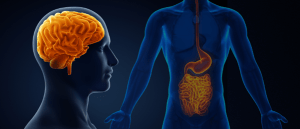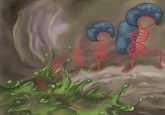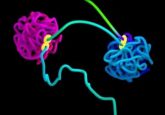The evolutionary balancing act that produced both advanced cognition and cognitive disease in humans

Refer a colleague
New research finds patterns of compensatory evolution in human-accelerated regions of the genome, which suggest these regions could be responsible for both increased cognition and cognitive disease in humans.
There’s an overused bit of pseudo-wisdom masquerading as profundity that states something to the effect that a person’s greatest strength is often the source of their greatest weakness. One theory suggests that the evolution of advanced cognition is also the source of cognitive disorders in humans. Now, research produced by scientists at Gladstone Institutes (CA, USA) has discovered genetic evidence that may lend the old adage some weight.
It’s a well-established fact that humans share 99% of our DNA with chimpanzees. But that 1% makes quite a difference, begging the question: what’s going on with that?
Conveniently, researchers from Gladstone Institutes asked a far more precise question: why did sections of the human genome abruptly diverge at great speed from stable ancestral DNA? Their research examined the divergent segments of the genome known as human accelerated regions (HARs). These are sections of the human genome that display an exceptional amount of difference, which sets it apart from other primate genomes, after millions of years of stasis. Back in 2006, when Katie Pollard, the study’s lead author, discovered HARs, her team noted that the vast majority were enhancers. Enhancers are concerned with regulatory processes directing gene activity.
In this study, the researchers utilized machine learning to analyze the patterns of hundreds of enhancers and non-enhancers in human and chimpanzee genomes, looking for indicators that can predict which DNA segments are enhancers. From the analysis, the algorithm was able to identify the signatures of brain enhancers. The model predicted that a third of HARs are responsible for brain development.
Each human HAR exhibits several differences from its corresponding chimpanzee equivalent. With this in mind, the team questioned the impact of individual HAR variation on enhancer strength. If the same eight nucleotides of DNA differed between humans and chimpanzees, do those differences result in a more or less potent enhancer?
The team had expected all changes to push enhancers in a singular direction, with the occasional outlier having no impact whatsoever. However, the results surprised them.
 Characterizing metabolite messengers: how the gut and brain communicate
Characterizing metabolite messengers: how the gut and brain communicate
A recent study investigated metabolites using a novel tool to find out how the gut and brain communicate.
To test their theory, the researchers used a second machine learning model, which returned a prediction that 43% of HARs contained a minimum of two opposed variants of significant effect. They then collaborated with laboratories at the University of California San Francisco (CA, USA), where they carried out lab experiments on over 700 HARs in precursors to human and chimpanzee brain cells. The data corroborated the predictions of the machine learning algorithm.
“What this kind of pattern indicates is something called compensatory evolution,” Pollard elaborated. “A large change was made in an enhancer, but maybe it was too much and led to harmful side effects, so the change was tuned back down over time—that’s why we see opposing effects.”
Pollard suggested that the discovery of HAR involvement in brain development means that their research may have significant implications for our understanding of both evolution and our own brains. Pollard speculates that the initial changes to HARs that resulted in increased cognition ran up against oppositional changes that restrained the chance of psychiatric risk – though she is quick to point out that her data can neither directly prove nor disprove this.
“We can never wind the clock back and know exactly what happened in evolution. But we can use all these scientific techniques to simulate what might have happened and identify which DNA changes are most likely to explain unique aspects of the human brain, including its propensity for psychiatric disease.”
The popular framing of evolution sometimes inadvertently suggests an almost mechanical set of decisions – if x then y. This may comfort our instinctive search for patterns and order; however, this research reinforces a more chaotic emergent reality. A link between advanced cognition and psychiatric disease has already been theorized, and it is perhaps poetic that one of our greatest assets as a species represents a bit of a double-edged blade, with the source of our cognition also producing the risk of psychiatric malady in accompaniment. But, as the cliché goes, knowledge is power, and further understanding of this field of research may reveal not only more about our evolution but also new means to effectively combat psychiatric disease, allowing us to better grasp the handle, rather than the knife.
Please enter your username and password below, if you are not yet a member of BioTechniques remember you can register for free.





